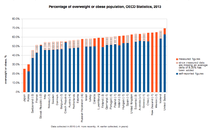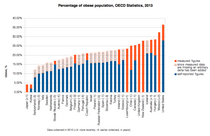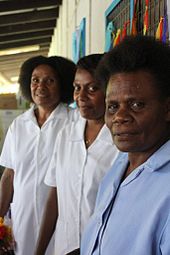Asian Health Care in the United States on Travel
Health, according to the World Health Organization, is "a state of consummate concrete, mental and social well-beingness and not merely the absenteeism of affliction and infirmity".[1] A multifariousness of definitions accept been used for different purposes over time. Health tin can exist promoted by encouraging healthful activities, such equally regular physical exercise and adequate sleep,[2] and by reducing or avoiding unhealthful activities or situations, such every bit smoking or excessive stress. Some factors affecting health are due to private choices, such as whether to engage in a high-take a chance behavior, while others are due to structural causes, such every bit whether the gild is bundled in a way that makes it easier or harder for people to get necessary healthcare services. Still other factors are beyond both individual and group choices, such as genetic disorders.
History
The meaning of wellness has evolved over time. In keeping with the biomedical perspective, early on definitions of health focused on the theme of the body's ability to role; health was seen as a state of normal function that could be disrupted from time to time by illness. An example of such a definition of health is: "a land characterized past anatomic, physiologic, and psychological integrity; ability to perform personally valued family, work, and customs roles; ability to deal with physical, biological, psychological, and social stress".[3] And so, in 1948, in a radical deviation from previous definitions, the World Health Organization (WHO) proposed a definition that aimed college, linking health to well-beingness, in terms of "physical, mental, and social well-beingness, and not but the absence of disease and infirmity".[4] Although this definition was welcomed past some as beingness innovative, it was also criticized for being vague and excessively wide and was non construed equally measurable. For a long time, it was set aside every bit an impractical platonic, with most discussions of health returning to the practicality of the biomedical model.[5]
Merely as in that location was a shift from viewing disease as a state to thinking of it every bit a procedure, the same shift happened in definitions of wellness. Again, the WHO played a leading role when it fostered the development of the health promotion movement in the 1980s. This brought in a new conception of wellness, not equally a country, but in dynamic terms of resiliency, in other words, as "a resource for living". In 1984, WHO revised the definition of health defined it equally "the extent to which an private or group is able to realize aspirations and satisfy needs and to change or cope with the environment. Health is a resource for everyday life, not the objective of living; it is a positive concept, emphasizing social and personal resources, likewise as physical capacities."[half dozen] Thus, health referred to the power to maintain homeostasis and recover from agin events. Mental, intellectual, emotional and social health referred to a person's ability to handle stress, to acquire skills, to maintain relationships, all of which form resources for resiliency and contained living.[5] This opens up many possibilities for health to exist taught, strengthened and learned.
Since the tardily 1970s, the federal Healthy People Program has been a visible component of the United States' approach to improving population wellness.[7] [8] In each decade, a new version of Healthy People is issued,[9] featuring updated goals and identifying topic areas and quantifiable objectives for health comeback during the succeeding ten years, with assessment at that indicate of progress or lack thereof. Progress has been limited to many objectives, leading to concerns well-nigh the effectiveness of Salubrious People in shaping outcomes in the context of a decentralized and uncoordinated US wellness system. Healthy People 2020 gives more prominence to health promotion and preventive approaches and adds a substantive focus on the importance of addressing social determinants of health. A new expanded digital interface facilitates use and dissemination rather than beefy printed books equally produced in the by. The impact of these changes to Salubrious People will exist determined in the coming years.[ten]
Systematic activities to prevent or cure health issues and promote practiced health in humans are undertaken by health care providers. Applications with regard to animal wellness are covered by the veterinarian sciences. The term "healthy" is too widely used in the context of many types of non-living organizations and their impacts for the benefit of humans, such equally in the sense of salubrious communities, salubrious cities or healthy environments. In addition to wellness care interventions and a person'southward environment, a number of other factors are known to influence the health status of individuals. These are referred to every bit the "determinants of health", which include the individual's background, lifestyle, economic status, social conditions and spirituality; Studies have shown that high levels of stress can bear on human health.[eleven]
In the beginning decade of the 21st century, the conceptualization of health as an power opened the door for self-assessments to become the main indicators to approximate the functioning of efforts aimed at improving human health.[12] It also created the opportunity for every person to experience healthy, fifty-fifty in the presence of multiple chronic diseases or a concluding condition, and for the re-examination of determinants of health (away from the traditional approach that focuses on the reduction of the prevalence of diseases).[13]
Determinants
In full general, the context in which an individual lives is of great importance for both his health status and quality of life. It is increasingly recognized that health is maintained and improved non only through the advancement and awarding of health science, but as well through the efforts and intelligent lifestyle choices of the individual and society. Co-ordinate to the World Health Arrangement, the master determinants of health include the social and economic environment, the physical environment, and the person's individual characteristics and behaviors.[fourteen]
More specifically, key factors that accept been found to influence whether people are healthy or unhealthy include the following:[fourteen] [xv] [16]

An increasing number of studies and reports from unlike organizations and contexts examine the linkages between health and different factors, including lifestyles, environments, health intendance organization and health policy, ane specific health policy brought into many countries in contempo years was the introduction of the sugar tax. Drinkable taxes came into light with increasing concerns about obesity, especially among youth. Sugar-sweetened beverages take go a target of anti-obesity initiatives with increasing show of their link to obesity.[17]– such as the 1974 Lalonde report from Canada;[16] the Alameda County Study in California;[18] and the series of Earth Health Reports of the Globe Health Organisation, which focuses on global wellness issues including access to wellness care and improving public health outcomes, especially in developing countries.[19]
The concept of the "health field," as distinct from medical care, emerged from the Lalonde report from Canada. The report identified three interdependent fields as key determinants of an private'due south health. These are:[16]
- Lifestyle: the aggregation of personal decisions (i.east., over which the individual has control) that can be said to contribute to, or crusade, disease or death;
- Environmental: all matters related to health external to the human trunk and over which the private has trivial or no control;
- Biomedical: all aspects of health, physical and mental, developed within the human body as influenced by genetic make-up.
The maintenance and promotion of health is achieved through different combination of physical, mental, and social well-beingness—a combination sometimes referred to every bit the "wellness triangle." [20] [21] The WHO'southward 1986 Ottawa Charter for Health Promotion further stated that wellness is non just a state, but too "a resource for everyday life, non the objective of living. Health is a positive concept emphasizing social and personal resource, as well every bit concrete capacities."[22]
Focusing more on lifestyle issues and their relationships with functional health, information from the Alameda County Study suggested that people can improve their health via exercise, enough slumber, spending time in nature, maintaining a salubrious body weight, limiting alcohol use, and fugitive smoking.[23] Health and illness can co-exist, as fifty-fifty people with multiple chronic diseases or terminal illnesses tin can consider themselves healthy.[24]
The environment is frequently cited as an of import cistron influencing the health status of individuals. This includes characteristics of the natural environment, the built environment and the social environs. Factors such every bit make clean water and air, acceptable housing, and safe communities and roads all have been establish to contribute to adept health, peculiarly to the health of infants and children.[xiv] [25] Some studies accept shown that a lack of neighborhood recreational spaces including natural surround leads to lower levels of personal satisfaction and higher levels of obesity, linked to lower overall health and well-beingness.[26] It has been demonstrated that increased fourth dimension spent in natural environments is associated with improved self-reported health,[27] suggesting that the positive wellness benefits of natural space in urban neighborhoods should exist taken into business relationship in public policy and country use.
Genetics, or inherited traits from parents, also play a role in determining the health status of individuals and populations. This tin embrace both the predisposition to certain diseases and health weather, equally well as the habits and behaviors individuals develop through the lifestyle of their families. For example, genetics may play a role in the style in which people cope with stress, either mental, emotional or physical. For case, obesity is a significant problem in the United States that contributes to poor mental health and causes stress in the lives of many people.[28] One difficulty is the issue raised by the debate over the relative strengths of genetics and other factors; interactions between genetics and environment may be of item importance.
Potential issues
A number of health issues are mutual around the earth. Illness is one of the most common. According to GlobalIssues.org, approximately 36 million people die each twelvemonth from non-communicable (i.e., non contagious) diseases, including cardiovascular disease, cancer, diabetes and chronic lung disease.[29]
Among communicable diseases, both viral and bacterial, AIDS/HIV, tuberculosis, and malaria are the most common, causing millions of deaths every year.[29]
Another health issue that causes death or contributes to other health problems is malnutrition, especially among children. One of the groups malnutrition affects nigh is young children. Approximately 7.5 million children under the age of 5 die from malnutrition, usually brought on by not having the money to find or make food.[29]
Bodily injuries are besides a common wellness consequence worldwide. These injuries, including bone fractures and burns, can reduce a person's quality of life or can crusade fatalities including infections that resulted from the injury (or the severity injury in general).[30] [29]
Lifestyle choices are contributing factors to poor health in many cases. These include smoking cigarettes, and can too include a poor diet, whether information technology is overeating or an overly constrictive diet. Inactivity tin as well contribute to wellness issues and likewise a lack of sleep, excessive alcohol consumption, and neglect of oral hygiene.[30] In that location are also genetic disorders that are inherited by the person and can vary in how much they affect the person (and when they surface).[thirty]
Although the majority of these health issues are preventable, a major contributor to global ill wellness is the fact that approximately 1 billion people lack admission to health care systems.[29] Arguably, the most common and harmful health issue is that a great many people practise not accept access to quality remedies.[31] [32]
Mental wellness
The World Health Organization describes mental health as "a country of well-being in which the individual realizes his or her own abilities, can cope with the normal stresses of life, can work productively and fruitfully, and is able to make a contribution to his or her community".[33] Mental health is not just the absence of mental affliction.[34]
Mental illness is described as 'the spectrum of cerebral, emotional, and behavioral weather condition that interfere with social and emotional well-being and the lives and productivity of people. Having a mental disease can seriously impair, temporarily or permanently, the mental functioning of a person. Other terms include: 'mental health problem', 'illness', 'disorder', 'dysfunction'.[35]
Approximately twenty per centum of all adults in the US are considered diagnosable with a mental illness. Mental illnesses are the leading cause of disability in the U.s. and Canada. Examples of these illnesses include schizophrenia, ADHD, major depressive disorder, bipolar disorder, anxiety disorder, post-traumatic stress disorder and autism.[36]
Many factors contribute to mental wellness problems, including:[37]
- Biological factors, such equally genes or brain chemistry
- Life experiences, such as trauma or abuse
- Family history of mental health bug
Maintaining
Achieving and maintaining health is an ongoing procedure, shaped by both the evolution of health intendance cognition and practices equally well equally personal strategies and organized interventions for staying healthy.
Diet

Percentage of overweight or obese population in 2010, Data source: OECD'southward iLibrary.[38] [39]

Percentage of obese population in 2010, Data source: OECD'due south iLibrary.[38] [40]
An important way to maintain one's personal health is to have a healthy diet. A healthy nutrition includes a variety of found-based and fauna-based foods that provide nutrients to the body. Such nutrients provide the body with free energy and keep information technology running. Nutrients help build and strengthen bones, muscles, and tendons and also regulate body processes (i.e., blood pressure). Water is essential for growth, reproduction and expert wellness. Macronutrients are consumed in relatively large quantities and include proteins, carbohydrates, and fats and fatty acids. Micronutrients – vitamins and minerals – are consumed in relatively smaller quantities, but are essential to body processes.[41] The nutrient guide pyramid is a pyramid-shaped guide of healthy foods divided into sections. Each department shows the recommended intake for each food group (i.e., protein, fat, carbohydrates and sugars). Making healthy food choices can lower one's risk of centre disease and the risk of developing some types of cancer, and tin help one maintain their weight within a healthy range.[42]
The Mediterranean nutrition is unremarkably associated with wellness-promoting effects. This is sometimes attributed to the inclusion of bioactive compounds such every bit phenolic compounds, isoprenoids and alkaloids.[43]
Exercise
Concrete exercise enhances or maintains concrete fitness and overall health and wellness. It strengthens one'southward basic and muscles and improves the cardiovascular organization. According to the National Institutes of Health, there are four types of practice: endurance, strength, flexibility, and remainder.[44] The CDC states that physical exercise can reduce the risks of heart disease, cancer, type two diabetes, high blood pressure, obesity, low, and anxiety.[45] For the purpose of counteracting possible risks, it is oftentimes recommended to start physical do gradually equally one goes. Participating in any exercising, whether information technology is housework, yardwork, walking or standing up when talking on the phone, is often idea to be better than none when information technology comes to health.[46]
Slumber
Sleep is an essential component to maintaining health. In children, slumber is also vital for growth and development. Ongoing sleep impecuniousness has been linked to an increased take chances for some chronic health problems. In improver, slumber deprivation has been shown to correlate with both increased susceptibility to illness and slower recovery times from affliction.[47] In one study, people with chronic insufficient slumber, set as half dozen hours of sleep a night or less, were found to be iv times more than likely to catch a cold compared to those who reported sleeping for seven hours or more a night.[48] Due to the role of sleep in regulating metabolism, bereft sleep may besides play a role in weight gain or, conversely, in impeding weight loss.[49] Additionally, in 2007, the International Agency for Research on Cancer, which is the cancer enquiry agency for the Earth Health Organization, alleged that "shiftwork that involves cyclic disruption is probably carcinogenic to humans," speaking to the dangers of long-term nighttime work due to its intrusion on sleep.[50] In 2015, the National Sleep Foundation released updated recommendations for sleep duration requirements based on age, and concluded that "Individuals who habitually sleep exterior the normal range may be exhibiting signs or symptoms of serious health problems or, if done volitionally, may be compromising their health and well-being."[51]
| Age and condition | Sleep Needs |
|---|---|
| Newborns (0–3 months) | 14 to 17 hours |
| Infants (4–11 months) | 12 to xv hours |
| Toddlers (1–two years) | eleven to 14 hours |
| Preschoolers (3–v years) | x to 13 hours |
| Schoolhouse-historic period children (half dozen–13 years) | nine to eleven hours |
| Teenagers (14–17 years) | 8 to 10 hours |
| Adults (18–64 years) | seven to 9 hours |
| Older Adults (65 years and over) | 7 to 8 hours |
Role of science
The Dutch Public Wellness Service provides medical care for the natives of the Dutch East Indies, May 1946
Health science is the branch of science focused on health. At that place are two main approaches to health science: the report and inquiry of the body and wellness-related issues to understand how humans (and animals) office, and the application of that knowledge to improve wellness and to prevent and cure diseases and other concrete and mental impairments. The science builds on many sub-fields, including biology, biochemistry, physics, epidemiology, pharmacology, medical folklore. Applied health sciences endeavor to improve empathise and improve human health through applications in areas such as health pedagogy, biomedical engineering, biotechnology and public health.
Organized interventions to improve wellness based on the principles and procedures adult through the health sciences are provided by practitioners trained in medicine, nursing, nutrition, pharmacy, social work, psychology, occupational therapy, concrete therapy and other health care professions. Clinical practitioners focus mainly on the wellness of individuals, while public health practitioners consider the overall health of communities and populations. Workplace health programs are increasingly being adopted by companies for their value in improving the health and well-existence of their employees, equally are school health services in guild to improve the health and well-beingness of children.
Function of medicine and medical science
Contemporary medicine is in general conducted inside health care systems. Legal, credentialing and financing frameworks are established by individual governments, augmented on occasion by international organizations, such as churches. The characteristics of any given wellness intendance organisation have pregnant bear upon on the way medical care is provided.
From ancient times, Christian emphasis on practical charity gave rise to the development of systematic nursing and hospitals and the Cosmic Church today remains the largest not-government provider of medical services in the world.[52] Advanced industrial countries (with the exception of the U.s.a.)[53] [54] and many developing countries provide medical services through a system of universal health intendance that aims to guarantee care for all through a single-payer wellness care system, or compulsory private or co-operative health insurance. This is intended to ensure that the unabridged population has access to medical care on the ground of need rather than ability to pay. Delivery may be via private medical practices or by state-owned hospitals and clinics, or by charities, virtually commonly by a combination of all three.
Most tribal societies provide no guarantee of healthcare for the population as a whole. In such societies, healthcare is bachelor to those that can afford to pay for it or accept self-insured it (either straight or as function of an employment contract) or who may be covered by intendance financed by the government or tribe directly.

Transparency of information is another factor defining a delivery system. Access to data on weather condition, treatments, quality, and pricing profoundly affects the choice by patients/consumers and, therefore, the incentives of medical professionals. While the US healthcare organization has come under burn down for lack of openness,[55] new legislation may encourage greater openness. There is a perceived tension between the need for transparency on the one hand and such issues as patient confidentiality and the possible exploitation of data for commercial gain on the other.
Delivery
Provision of medical care is classified into primary, secondary, and third care categories.[56]

Primary intendance medical services are provided past physicians, doc administration, nurse practitioners, or other health professionals who accept first contact with a patient seeking medical treatment or care.[57] These occur in doctor offices, clinics, nursing homes, schools, home visits, and other places close to patients. Well-nigh 90% of medical visits can be treated past the primary care provider. These include treatment of acute and chronic illnesses, preventive care and health educational activity for all ages and both sexes.
Secondary intendance medical services are provided by medical specialists in their offices or clinics or at local community hospitals for a patient referred by a master care provider who first diagnosed or treated the patient.[58] Referrals are made for those patients who required the expertise or procedures performed by specialists. These include both ambulatory intendance and inpatient services, Emergency departments, intensive intendance medicine, surgery services, physical therapy, labor and commitment, endoscopy units, diagnostic laboratory and medical imaging services, hospice centers, etc. Some primary care providers may also accept care of hospitalized patients and deliver babies in a secondary intendance setting.
Third intendance medical services are provided by specialist hospitals or regional centers equipped with diagnostic and treatment facilities non generally bachelor at local hospitals. These include trauma centers, burn treatment centers, advanced neonatology unit services, organ transplants, loftier-risk pregnancy, radiation oncology, etc.
Modern medical care besides depends on information – still delivered in many wellness care settings on paper records, but increasingly nowadays by electronic means.
In low-income countries, mod healthcare is often likewise expensive for the boilerplate person. International healthcare policy researchers have advocated that "user fees" be removed in these areas to ensure access, although even afterwards removal, significant costs and barriers remain.[59]
Separation of prescribing and dispensing is a do in medicine and chemist's shop in which the doctor who provides a medical prescription is independent from the chemist who provides the prescription drug. In the Western world at that place are centuries of tradition for separating pharmacists from physicians. In Asian countries, it is traditional for physicians to also provide drugs.[60]
Role of public health

Postage postage stamp, New Zealand, 1933. Public health has been promoted – and depicted – in a wide variety of ways.
Public health has been described every bit "the science and fine art of preventing affliction, prolonging life and promoting health through the organized efforts and informed choices of society, organizations, public and private, communities and individuals."[61] Information technology is concerned with threats to the overall health of a community based on population health assay. The population in question can be as small equally a handful of people or as big as all the inhabitants of several continents (for instance, in the example of a pandemic). Public health has many sub-fields, but typically includes the interdisciplinary categories of epidemiology, biostatistics and wellness services. Environmental health, community health, behavioral health, and occupational health are likewise important areas of public health.
The focus of public health interventions is to forestall and manage diseases, injuries and other health conditions through surveillance of cases and the promotion of good for you behavior, communities, and (in aspects relevant to man health) environments. Its aim is to forestall health problems from happening or re-occurring by implementing educational programs, developing policies, administering services and conducting research.[62] In many cases, treating a disease or controlling a pathogen tin be vital to preventing information technology in others, such as during an outbreak. Vaccination programs and distribution of condoms to prevent the spread of infectious disease are examples of mutual preventive public wellness measures, equally are educational campaigns to promote vaccination and the use of condoms (including overcoming resistance to such).
Public health likewise takes diverse actions to limit the health disparities between unlike areas of the country and, in some cases, the continent or world. One outcome is the admission of individuals and communities to health intendance in terms of financial, geographical or socio-cultural constraints.[63] Applications of the public health arrangement include the areas of maternal and child wellness, health services assistants, emergency response, and prevention and command of infectious and chronic diseases.
The not bad positive impact of public wellness programs is widely best-selling. Due in part to the policies and actions developed through public wellness, the 20th century registered a decrease in the bloodshed rates for infants and children and a continual increment in life expectancy in about parts of the world. For case, it is estimated that life expectancy has increased for Americans by xxx years since 1900,[64] and worldwide by six years since 1990.[65]
Cocky-care strategies

A lady washing her hands c. 1655
Personal health depends partially on the active, passive, and assisted cues people observe and prefer near their ain health. These include personal actions for preventing or minimizing the effects of a disease, commonly a chronic condition, through integrative care. They besides include personal hygiene practices to foreclose infection and affliction, such as bathing and washing hands with lather; brushing and flossing teeth; storing, preparing and handling food safely; and many others. The information gleaned from personal observations of daily living – such as about sleep patterns, exercise behavior, nutritional intake and environmental features – may be used to inform personal decisions and actions (e.k., "I feel tired in the morn so I am going to try sleeping on a different pillow"), equally well as clinical decisions and treatment plans (e.thousand., a patient who notices his or her shoes are tighter than usual may be having exacerbation of left-sided heart failure, and may require diuretic medication to reduce fluid overload).[66]
Personal wellness also depends partially on the social construction of a person's life. The maintenance of stiff social relationships, volunteering, and other social activities have been linked to positive mental health and as well increased longevity. One American study amongst seniors over age 70, found that frequent volunteering was associated with reduced risk of dying compared with older persons who did not volunteer, regardless of physical health status.[67] Another study from Singapore reported that volunteering retirees had significantly ameliorate cognitive performance scores, fewer depressive symptoms, and better mental well-being and life satisfaction than non-volunteering retirees.[68]
Prolonged psychological stress may negatively impact health, and has been cited every bit a factor in cognitive impairment with crumbling, depressive illness, and expression of disease.[69] Stress direction is the application of methods to either reduce stress or increase tolerance to stress. Relaxation techniques are physical methods used to relieve stress. Psychological methods include cognitive therapy, meditation, and positive thinking, which work by reducing response to stress. Improving relevant skills, such every bit problem solving and time direction skills, reduces uncertainty and builds confidence, which also reduces the reaction to stress-causing situations where those skills are applicable.
Occupational
In addition to safe risks, many jobs also present risks of affliction, illness and other long-term health issues. Among the most common occupational diseases are various forms of pneumoconiosis, including silicosis and coal worker'south pneumoconiosis (black lung disease). Asthma is some other respiratory illness that many workers are vulnerable to. Workers may also exist vulnerable to skin diseases, including eczema, dermatitis, urticaria, sunburn, and skin cancer.[lxx] [71] Other occupational diseases of concern include carpal tunnel syndrome and lead poisoning.
Every bit the number of service sector jobs has risen in adult countries, more and more than jobs take become sedentary, presenting a different assortment of health problems than those associated with manufacturing and the primary sector. Gimmicky issues, such every bit the growing rate of obesity and issues relating to stress and overwork in many countries, have further complicated the interaction between piece of work and health.
Many governments view occupational health as a social challenge and take formed public organizations to ensure the wellness and safe of workers. Examples of these include the British Health and Prophylactic Executive and in the United States, the National Establish for Occupational Prophylactic and Health, which conducts inquiry on occupational health and safety, and the Occupational Safety and Health Administration, which handles regulation and policy relating to worker safety and health.[72] [73] [74]
See also
- Disease burden
- Ecology health
- Healing
- Health equity
- Human enhancement
- Men'south wellness
- I Health
- Population wellness
- Women's health
- Youth health
- Listing of health and health podcasts
References
- ^ World Health Organisation. (2006). Constitution of the Globe Wellness Arrangement – Basic Documents, Forty-fifth edition, Supplement, October 2006.
- ^ CDC (2021-04-05). "Benefits of Physical Activity". Centers for Disease Control and Prevention . Retrieved 2021-09-11 .
- ^ Stokes, J.; Noren, J.; Shindell, S. (1982-01-01). "Definition of terms and concepts applicative to clinical preventive medicine". Journal of Community Health. 8 (1): 33–41. doi:ten.1007/bf01324395. ISSN 0094-5145. PMID 6764783. S2CID 1748896.
- ^ Earth Health Organization (1958). The first x years of the World Health Organization. Geneva: WHO. ISBN9789241560146.
- ^ a b "Role 1 – Theory: Thinking About Health Chapter 1 Concepts of Health and Illness". phprimer.afmc.ca. Archived from the original on 2016-08-12. Retrieved 2016-06-22 .
- ^ World Wellness Organization. Regional Office for Europe (1984). Wellness promotion : a discussion document on the concept and principles : summary report of the Working Group on Concept and Principles of Health Promotion, Copenhagen, nine–13 July 1984 (ICP/HSR 602(m01)5 p). Copenhagen: WHO Regional Office for Europe.
- ^ Federal Prevention Initiatives Archived 2016-06-15 at the Wayback Motorcar. U.Southward. Department of Wellness and Homo Services
- ^ Benz, J; Blakey, C; Oppenheimer, C.C; Scherer, H; Robinson, W.T (2013). "The salubrious people initiative: Understanding the user's perspective". Periodical of Public Health Management and Exercise. nineteen (2): 103–09. doi:x.1097/PHH.0b013e318254cc31. PMID 23358287.
- ^ History & Development of Salubrious People. U.S. Department of Wellness and Human being Services
- ^ Jonathan, East. Fielding; Shiriki, Kumanyika; Ronald, Due west. Manderscheid (2013). "A Perspective on the Evolution of the Good for you People 2020 Framework for Improving U.S. Population Health" (PDF). Public Health Reviews. 35. Archived from the original on 2014-04-02.
{{cite journal}}: CS1 maint: bot: original URL status unknown (link) - ^ "How stressed are you?". Bbc.co.britain. 2013-11-06. Retrieved 2014-03-01 .
- ^ Jadad, Alejandro R. (2016-11-01). "Creating a pandemic of health: What is the part of digital technologies?". Journal of Public Wellness Policy. 37 (2): 260–68. doi:10.1057/s41271-016-0016-1. ISSN 0197-5897. PMID 27899800.
- ^ "Creating a Pandemic of Health: Opportunities and Lessons for a University Initiative at the Intersection of Wellness, Equity, and Innovation | Harvard Public Health Review: A Pupil Publication". harvardpublichealthreview.org . Retrieved 2018-01-20 .
- ^ a b c World Health Organization. The determinants of wellness. Geneva. Accessed 12 May 2011.
- ^ Public Health Agency of Canada. What Determines Health? Ottawa. Accessed 12 May 2011.
- ^ a b c Lalonde, Marc (1974). "A New Perspective on the Health of Canadians." Ottawa: Minister of Supply and Services. Archived 2014-10-28 at the Wayback Machine
- ^ Andreyeva, Tatiana; Chaloupka, Frank J.; Brownell, Kelly D. (2011). "Estimating the potential of taxes on saccharide-sweetened beverages to reduce consumption and generate acquirement". Preventive Medicine. 52 (6): 413–sixteen. doi:x.1016/j.ypmed.2011.03.013. PMID 21443899.
- ^ Housman, Jeff; Dorman, Steve (September–October 2005). "The Alameda County Study: A Systematic, Chronological Review" (PDF). American Journal of Wellness Education. 36 (five): 302–08. doi:10.1080/19325037.2005.10608200. ISSN 1055-6699. S2CID 39133965. ERIC certificate number EJ792845. Retrieved 27 December 2011.
- ^ Globe Wellness Organization. The world wellness study. Geneva.
- ^ Georgia State University. 1998. Wellness Triangle Slides.
- ^ Nutter S. (2003) The Health Triangle. Anchor Points, Inc., ISBN 0-9748760-0-3.
- ^ World Health Organization. The Ottawa Lease for Health Promotion. Adopted at the Outset International Conference on Health Promotion, Ottawa, 21 Nov 1986 – WHO/HPR/HEP/95.1.
- ^ Housman & Dorman 2005, pp. 303–04. "The linear model supported previous findings, including regular exercise, limited alcohol consumption, abstinence from smoking, sleeping seven–8 hours a night, and maintenance of a healthy weight play an important function in promoting longevity and delaying illness and death." Citing Wingard DL, Berkman LF, Brand RJ (1982). "A multivariate analysis of wellness-related practices: a nine-year mortality follow-upwards of the Alameda County Study". Am J Epidemiol. 116 (5): 765–75. doi:10.1093/oxfordjournals.aje.a113466. PMID 7148802.
- ^ Jadad, A.R. (2013). "On Living a Long, Healthy, and Happy Life, Full of Love, and with no Regrets, until Our Last Breath". Verhaltenstherapie. 23 (4): 287–89. doi:x.1159/000357490.
- ^ UNESCO. The UN Globe H2o Development Report: Facts and Figures – Meeting basic needs. Accessed 12 May 2011.
- ^ Björk J, Albin Yard, Grahn P, Jacobsson H, Ardö J, Wadbro J, Ostergren PO (2008). "Recreational Values of the Natural Environment in Relation to Neighborhood Satisfaction, Physical Action, Obesity and Well beingness" (PDF). Journal of Epidemiology & Community Health. 62 (4): e2. doi:x.1136/jech.2007.062414. PMID 18365329. S2CID 13859588.
- ^ White, Mathew P.; Alcock, Ian; Grellier, James; Wheeler, Benedict W.; Hartig, Terry; Warber, Sara L.; Depledge, Michael H.; Fleming, Lora Eastward. (2019-06-xiii). "Spending at to the lowest degree 120 minutes a week in nature is associated with skilful wellness and wellbeing". Scientific Reports. nine (1): 7730. Bibcode:2019NatSR...9.7730W. doi:10.1038/s41598-019-44097-3. ISSN 2045-2322. PMC6565732. PMID 31197192.
- ^ Kantola, Jussi Ilari; Barath, Tibor; Nazir, Salman; Andre, Terence (2017). Advances in Human Factors, Business Direction, Training and Education | SpringerLink. Advances in Intelligent Systems and Computing. Vol. 498. doi:10.1007/978-3-319-42070-7. ISBN978-3-319-42069-i.
- ^ a b c d e Shah, Anup (5 January 2014). "Health Issues." Global Issues.
- ^ a b c Moffett 2013. sfn error: no target: CITEREFMoffett2013 (help)
- ^ "United nations Global Issues". Un.org. Archived from the original on 2016-06-08.
{{cite spider web}}: CS1 maint: bot: original URL status unknown (link) - ^ "The Top 10 Global Health Issues to Watch in 2013". Intrahealth.org. Retrieved 2014-03-01 .
- ^ Globe Health Organization (2005). Promoting Mental Health: Concepts, Emerging evidence, Practice: A report of the World Health Organization, Department of Mental Health and Substance Abuse in collaboration with the Victorian Wellness Promotion Foundation and the University of Melbourne. Globe Health Organization. Geneva.
- ^ Bos, East.H.; Snippe, E.; de Jonge, P.; Jeronimus, B.F. (2016). "Preserving Subjective Wellbeing in the Face up of Psychopathology: Buffering Furnishings of Personal Strengths and Resources". PLOS One. eleven (3): e0150867. Bibcode:2016PLoSO..1150867B. doi:x.1371/journal.pone.0150867. PMC4786317. PMID 26963923.
- ^ Long, Steven West. Lifestyle Direction: Achieving & Maintaining Proficient Healt. niu.edu.tw
- ^ The numbers count: Mental disorders in America Archived 2014-07-28 at the Wayback Machine. nih.gov
- ^ "What Is Mental Wellness?" (5 Apr 2019). MentalHealth.gov. Retrieved xvi Nov 2019.
- ^ a b "OECD Statistics". stats.oecd.org.
- ^ "OECD.StatExtracts, Health, Not-Medical Determinants of Wellness, Body weight, Overweight or obese population, cocky-reported and measured, Full population" (Online Statistics). OECD's iLibrary. 2013. Retrieved 2013-12-12 .
- ^ "OECD.StatExtracts, Wellness, Not-Medical Determinants of Wellness, Body weight, Obese population, self-reported and measured, Total population" (Online Statistics). OECD's iLibrary. 2013. Retrieved 2013-12-thirteen .
- ^ "WHO | Nutrients". WHO. Archived from the original on September 26, 2011. Retrieved 2019-09-24 .
- ^ "Healthy Eating: Why should I make healthy nutrient choices?". Livelifewell.nsw.gov.au. Archived from the original on 2014-02-27. Retrieved 2014-03-01 .
- ^ Garrido G; González-Flores D; Marchena AM; Propr Eastward; García-Parra J; Barriga C; Rodríguez A.B. (2013). "A lycopene-enriched virgin olive oil enhances antioxidant status in humans". Journal of the Science of Food and Agronomics. 93 (8): 1820–26. doi:x.1002/jsfa.5972. PMID 23225211.
- ^ "4 Types of Practice". Go4Life, National Institute on Aging, United states of america National Institutes of Wellness. 15 May 2014.
- ^ "CDC | Physical Activity | Facts | Salubrious Schools". www.cdc.gov. 2020-04-21. Retrieved 2021-05-30 .
- ^ "Health Risks of an Inactive Lifestyle". medlineplus.gov . Retrieved 2021-05-30 .
- ^ Pilkington, Stephanie (August vii, 2013). "Causes and consequences of sleep deprivation in hospitalized patients". Nursing Standard. 27 (49): 35–42. doi:10.7748/ns2013.08.27.49.35.e7649. PMID 23924135.
- ^ Shilo Rea (2015-08-31). "New Research Confirms Lack of Sleep Connected to Getting Sick". cmu.edu. Retrieved 2015-11-25 .
- ^ Patel, Sanjay R.; Hu, Frank B. (January 17, 2008). "Short sleep duration and weight gain: a systematic review". Obesity (Silver Spring). 16 (iii): 643–53. doi:x.1038/oby.2007.118. PMC2723045. PMID 18239586.
- ^ "IARC Monographs Program finds cancer hazards associated with shiftwork, painting and firefighting". International Agency for Research on Cancer. Dec 5, 2007. Archived from the original on July 21, 2011. Retrieved November 25, 2015.
- ^ Hirshkowitz, Max; Whiton, Kaitlyn; et al. (xiv Jan 2015). "National Sleep Foundation's slumber fourth dimension elapsing recommendations: methodology and results summary". Slumber Health. 1 (1): xl–43. doi:10.1016/j.sleh.2014.12.010. PMID 29073412. Retrieved 25 November 2015.
- ^ Blainey G (2011). A Short History of Christianity. Penguin Viking. OCLC 793902685. [ page needed ]
- ^ "Insuring America's Health: Principles and Recommendations". Institute of Medicine at the National Academies of Science. xiv Jan 2004. Archived from the original on nineteen Oct 2009.
- ^ "The Case For Single Payer, Universal Health Care for the United states". Cthealth.server101.com. Archived from the original on 23 Apr 2018. Retrieved four May 2009.
- ^ Sipkoff M (January 2004). "Transparency chosen key to uniting price control, quality improvement". Managed Care. 13 (1): 38–42. PMID 14763279. Archived from the original on 17 Feb 2004. Retrieved 16 Apr 2006.
- ^ "Primary, Secondary and Tertiary HealthCare – Arthapedia". www.arthapedia.in. Archived from the original on 28 January 2021. Retrieved 19 January 2021.
- ^ "Types of health intendance providers: MedlinePlus Medical Encyclopedia". medlineplus.gov. Archived from the original on 23 Jan 2021. Retrieved nineteen January 2021.
- ^ "Secondary Wellness Intendance". International Medical Corps. Archived from the original on 17 January 2021. Retrieved 19 Jan 2021.
- ^ Laokri S, Weil O, Drabo KM, Dembelé SM, Kafando B, Dujardin B (Apr 2013). "Removal of user fees no guarantee of universal health coverage: observations from Burkina Faso". Message of the World Health Arrangement. 91 (four): 277–82. doi:10.2471/BLT.12.110015. PMC3629451. PMID 23599551.
- ^ Chou YJ, Yip WC, Lee CH, Huang N, Sun YP, Chang HJ (September 2003). "Impact of separating drug prescribing and dispensing on provider behaviour: Taiwan'due south experience". Health Policy and Planning. xviii (3): 316–29. doi:x.1093/heapol/czg038. PMID 12917273.
- ^ Winslow CE (1920). "The Untilled Fields of Public Health". Scientific discipline. 51 (1306): 23–33. Bibcode:1920Sci....51...23W. doi:10.1126/science.51.1306.23. PMID 17838891.
- ^ Association of Schools of Public Health. What is Public Health? Retrieved 2010-06-24
- ^ Hispanics and the Future of America. Admission to and Quality of Health Care
- ^ Association of Schools of Public Health. Bear upon of Public Health. Retrieved 2010-six-24.
- ^ World Health Organization. Life expectancy at birth, accessed 20 April 2011.
- ^ Robert Wood Johnson Foundation. (2008). Wellness in Everyday Living.
- ^ Harris AH, Thoresen CE (2005). "Volunteering is Associated with Delayed Mortality in Older People: Analysis of the Longitudinal Written report of Crumbling" (PDF). Journal of Health Psychology. ten (half-dozen): 739–52. doi:10.1177/1359105305057310. PMID 16176953. S2CID 23314208. Archived from the original (PDF) on 2011-07-22.
- ^ Schwingel A, Niti MM, Tang C, Ng TP (2009). "Continued work employment and volunteerism and mental well-existence of older adults: Singapore longitudinal ageing studies". Age and Ageing. 38 (five): 531–37. doi:ten.1093/ageing/afp089. PMID 19474036.
- ^ McEwen BS (2006). "Protective and damaging effects of stress mediators: cardinal office of the brain". Dialogues Clin Neurosci. 8 (4): 367–81. doi:ten.31887/DCNS.2006.8.four/bmcewen. PMC3181832. PMID 17290796.

- ^ HSE (Health and Safety Executive of U.k.) Skin at piece of work Retrieved on June twenty, 2009
- ^ "Skin Exposure & Effects". NIOSH Topics. National Institute for Occupational Condom and Wellness. Retrieved 7 August 2012.
- ^ "The National Establish for Occupational Safety and Health". Centers for Disease Control and Prevention. Retrieved vii August 2012.
- ^ "Occupational Safety and Wellness Administration". U.Southward. Department of Labor. Retrieved vii August 2012.
- ^ "Health and Safety Executive". U.K. Health and Safety Executive. Retrieved seven August 2012.
External links
| | Wikiquote has quotations related to: Health |
-
 Media related to Health at Wikimedia Commons
Media related to Health at Wikimedia Commons
0 Response to "Asian Health Care in the United States on Travel"
Post a Comment